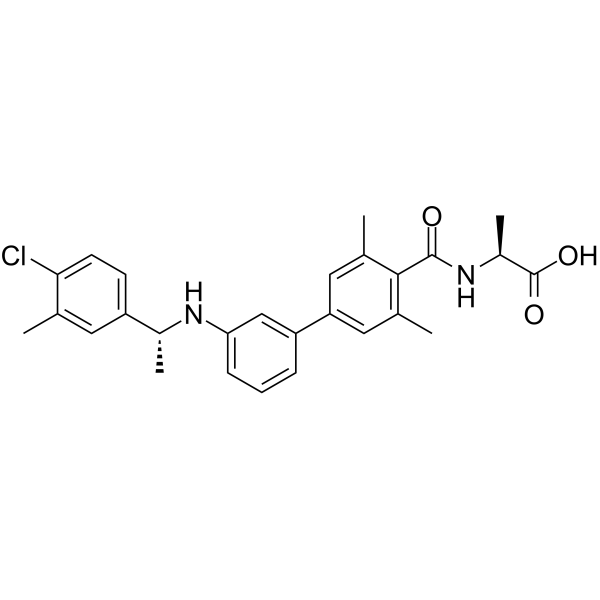1233332-14-3
| Name | (S)-2-({3'-[(R)-1-(4-Chloro-3-methyl-phenyl)-ethylamino]-3,5-dimethyl-biphenyl-4-carbonyl}-amino)-propionic acid |
|---|
| Description | NIBR-0213 is a potent and selective S1P1 antagonist with efficacy in experimental autoimmune encephalomyelitis. NIBR-0213 displays potent and comparable potency on human and rat S1P1 (IC50 of 2.0 nM and 2.3 nM, respectively) in GTPγ35S assays[1]. |
|---|---|
| Related Catalog | |
| In Vitro | NIBR-0213 displays an inhibitory activity on hS1P1 with an IC50 of 2.5 nM whereas it is inactive (IC50 >10 μM) on S1P2, S1P3, and S1P4 in Ca2+ mobilization assays[1]. NIBR-0213 displays potent and comparable potency on human and rat S1P1 (IC50 of 2.0 nM and 2.3 nM, respectively) in GTPγ35S assays, whereas on mouse S1P1 with an IC50 of 8.5 nM[1]. NIBR-0213 shows an ∼3,000-fold selectivity against human S1P5 in the GTPγ35S assay[1]. NIBR-0213 is a competitive S1P1 antagonist with a calculated Kd of 0.37±0.031 nM[1]. |
| In Vivo | NIBR-0213 (given orally at 30 mg/kg to rats) reduces the peripheral blood lymphocyte (PBL) counts by 75%-85% within 14 hr and maintained this effect up to 24 hr posttreatment[1]. NIBR-0213 (30 mg/kg and 60 mg/kg) is efficacious when given therapeutically in a mouse experimental autoimmune encephalomyelitis (EAE) model[1]. The PK properties of NIBR-0213 shows a moderate clearance (26 mL/min/kg) and a high oral bioavailability (69%), leading to significant exposure after oral dosing[1]. Animal Model: Lewis or Wistar rats (220-250 g, males)[1] Dosage: 30 mg/kg Administration: Orally Result: Reduced the PBL counts by 75%-85% within 14 hr and maintained this effect up to 24 hr posttreatment. Animal Model: C57BL/6 mice bearing EAE model[1] Dosage: 30 mg/kg and 60 mg/kg Administration: 30 mg/kg twice per day (BID) for 3 days and then increased to 60 mg/kg BID until the remainder of the experiment. In total, the treatment lasted 26 days Result: Resulted in a gradual reduction in disease-scores, with a divergence from vehicle controls that became significant after 5 days. |
| References |
| Molecular Formula | C27H29ClN2O3 |
|---|---|
| Molecular Weight | 464.98 |
| Exact Mass | 464.18700 |
| PSA | 78.43000 |
| LogP | 6.77210 |
